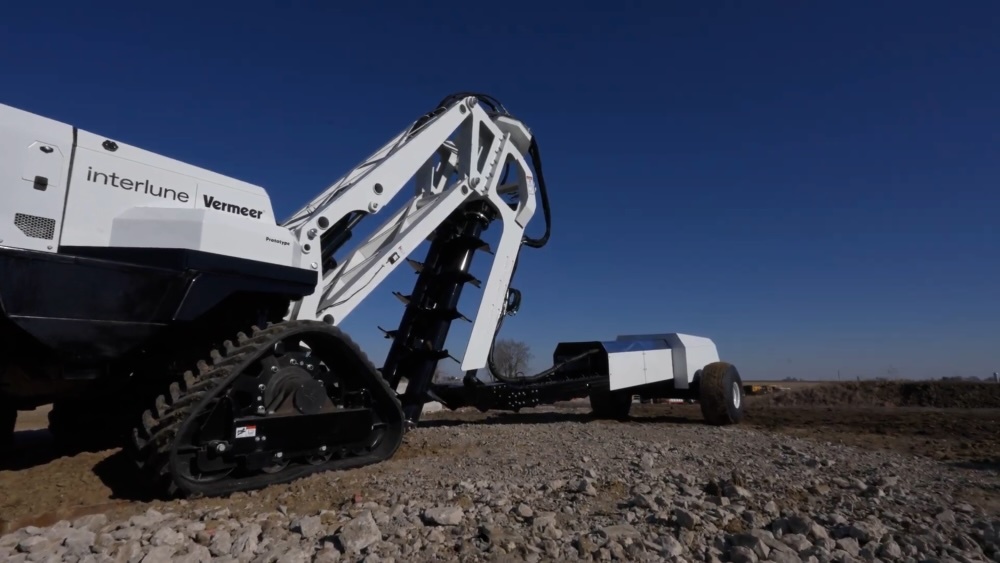10.05.2025

Interlune is testing lunar harvester prototypes with development partner Vermeer.
Seattle-based Interlune has won two contracts to sell thousands of liters of helium-3 excavated from the Moon’s surface and to deliver the rare gas to Earth.
Maybell Quantum, a quantum computing infrastructure company, agreed to purchase thousands of liters of helium-3 for yearly delivery from 2029-2035, Interlune said on May 7. The startup also signed a contract with the Department of Energy’s Isotope Program to sell three liters of helium-3 harvested from the lunar regolith at about today’s commercial market price, with delivery no later than April 2029.
Helium-3 is prized by quantum computer developers for its ultralow-temperature cooling capabilities. Nuclear fusion researchers seek it as a potential fuel for advanced, low-radiation reactors. The medical imaging sector is also interested in the gas for use in a specialized type of magnetic resonance imaging called hyperpolarized gas MRI.
The noble gas is hard to come by on Earth. Helium-3 is currently selling for “just under $3,000 a liter,” the equivalent of about $20 million per kilogram (2.2 lb.) at current prices, Interlune CEO Rob Meyerson tells Aviation Week. Interlune aims to bring back 20 kg (44 lb.) of helium-3 per year, the equivalent of about $400 million annually, starting in the early 2030s.
But helium-3 is just the beginning of the company’s ambitions. “We’re focused on helium-3 as our go-to-market [product], because it is the only thing out there that’s really priced high enough to go to space and bring it back today,” Meyerson says. “We want to establish the infrastructure to eventually produce rocket fuel–liquid oxygen, liquid hydrogen–and then industrial metals like iron, aluminum and titanium, silicon and then rare earth elements and, of course, water to support a growing in-space economy.”
Interlune also unveiled new details about its lunar excavator, a 23-ft. (7-m)-long, 15-ft. (4.6-m) tall machine that it is jointly developing with Vermeer Corp., an industrial and agricultural heavy machinery manufacturer. The excavator is designed to dig as deep as 3 m (9.8 ft.) into the lunar regolith, ingesting 100 metric tons of Moon dirt per hour and then returning the soil to the surface in a continuous motion.
“Helium-3 is implanted in the regolith in sort of the parts-per-billion kind of number, so we need to process a lot of lunar soil to get the helium-3 out,” Meyerson says. The system will cut into the lunar regolith at an angle, from the bottom, rather than the top, he adds.
“It is pulling the vehicle down to the surface of the ground, as opposed to pushing, cutting like a chain trench,” Meyerson says. “Traditional systems like chain trenchers generate a lot of dust.”
The harvester would be powered by arrays of solar panels deployed to the Moon’s surface that would distribute power wirelessly or using cables. The lunar harvesters would operate during the 14-Earth-day-long lunar day and hibernate during the 14-day night, restarting when the Sun rises.
Meyerson says Interlune is still considering technologies to help the harvester survive the lunar night, a harsh period when temperatures can drop to -173C (-279F), freezing, cracking and fracturing components. To separate helium-3 from the regolith, Interlune will use a cryogenic separation process.
“Helium-3 is sort of the coldest thing in the stack,” Meyerson says. “You’ve got a mixture of gases that are helium–normal balloon gas–hydrogen and other gases. You chill it down to a very, very low temperature, and the helium-3 is the only thing remaining.”
For its lunar mining operation, Interlune would need to bring “multiple tons of payload to the surface of the Moon,” he says. To get to the Moon, the company would rely on transport from SpaceX, Blue Origin, Firefly Aerospace or another lunar lander company. Samples would be returned via in-house-developed rockets. The company would buy a third-party lunar rover to set up the whole operation.
“We would need to bring something with us that can actually unpack, deploy, and help us commission all the robotic systems that need to be integrated together to perform all of this excavation,” Meyerson says.
Quelle: AVIATION WEEK
